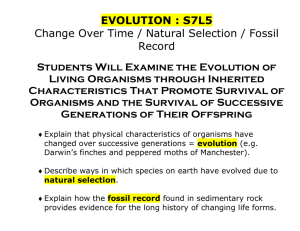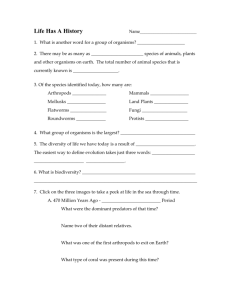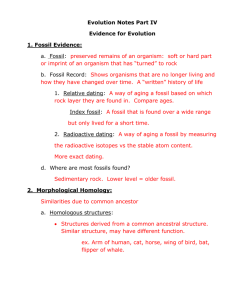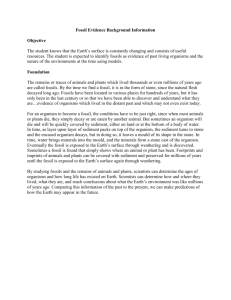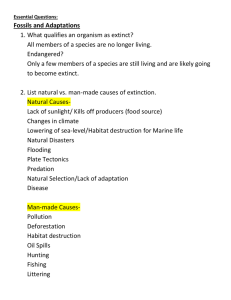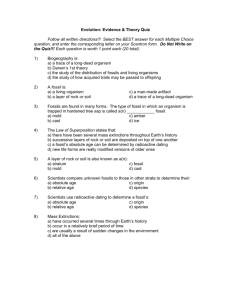Chapter 13 and 14 ReviewKey
advertisement
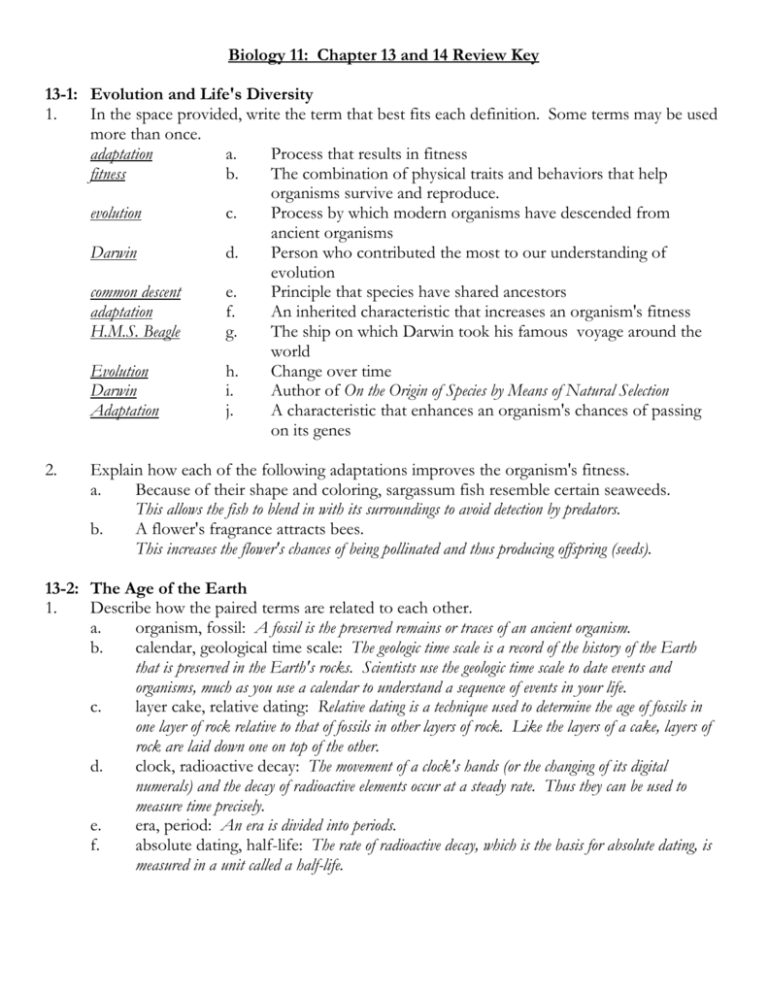
Biology 11: Chapter 13 and 14 Review Key 13-1: Evolution and Life's Diversity 1. In the space provided, write the term that best fits each definition. Some terms may be used more than once. adaptation a. Process that results in fitness fitness b. The combination of physical traits and behaviors that help organisms survive and reproduce. evolution c. Process by which modern organisms have descended from ancient organisms Darwin d. Person who contributed the most to our understanding of evolution common descent e. Principle that species have shared ancestors adaptation f. An inherited characteristic that increases an organism's fitness H.M.S. Beagle g. The ship on which Darwin took his famous voyage around the world Evolution h. Change over time Darwin i. Author of On the Origin of Species by Means of Natural Selection Adaptation j. A characteristic that enhances an organism's chances of passing on its genes 2. Explain how each of the following adaptations improves the organism's fitness. a. Because of their shape and coloring, sargassum fish resemble certain seaweeds. This allows the fish to blend in with its surroundings to avoid detection by predators. b. A flower's fragrance attracts bees. This increases the flower's chances of being pollinated and thus producing offspring (seeds). 13-2: The Age of the Earth 1. Describe how the paired terms are related to each other. a. organism, fossil: A fossil is the preserved remains or traces of an ancient organism. b. calendar, geological time scale: The geologic time scale is a record of the history of the Earth that is preserved in the Earth's rocks. Scientists use the geologic time scale to date events and organisms, much as you use a calendar to understand a sequence of events in your life. c. layer cake, relative dating: Relative dating is a technique used to determine the age of fossils in one layer of rock relative to that of fossils in other layers of rock. Like the layers of a cake, layers of rock are laid down one on top of the other. d. clock, radioactive decay: The movement of a clock's hands (or the changing of its digital numerals) and the decay of radioactive elements occur at a steady rate. Thus they can be used to measure time precisely. e. era, period: An era is divided into periods. f. absolute dating, half-life: The rate of radioactive decay, which is the basis for absolute dating, is measured in a unit called a half-life. 2. Both relative and absolute dating are used in the study of fossils. If you were a scientist, you would have to know which method to use in a given situation. The questions below reflect some of the problems that might be encountered in trying to date fossils. a. When would the layers of rocks not be a good indicator of the age of a fossil? When the layers had been disturbed and were no longer in their original order, they would not be an accurate source of information for dating purposes. b. Could you date a fossil over one million years old using carbon-14 dating? Explain your answer. It would be impossible to date a really old fossil using carbon-14 because it has too short a half-life. It is almost completely gone in about a half million years. 13-3: The Fossil Record 1. Write three complete sentences about each of the following terms that will tell something important about that word. a. paleontologist: A paleontologist is a scientist who studies fossils. Paleontologists have collected millions of fossils that make up the fossil record. Paleontologists can offer a relatively clear picture of the evolution of many organisms. b. fossil record: The fossil record represents the preserved collective history of the Earth's organisms. The fossil record has many missing pieces. The fossil record tells of major changes that have occurred in the Earth's climate and geography. 13-4: Evidence from Living Organisms 1. In YOUR own words, define each of the following terms: a. Homology: A relationship in which structures being compared correspond in form because they are derived from a shared primitive ancestral structure b. Embryo: An organism at a very early stage of development c. Vestigial organ: A useless or rudimentary organ that was more fully developed or functional earlier in the development of the species. d. Homologous structures: Structures that correspond in basic form because they are derived from a common ancestral structure. 14-1: Developing a Theory of Evolution 1. Read each of the following statements about evolutionary theory carefully. Indicate whether each statement is true or false. True Evolutionary change is undeniable. False Evolutionary theory is based on vague hunches. False Current evolutionary theory is exactly like Darwin's theory. True Much research in many branches of biology is based on evolutionary theory. False Because some of Darwin's original theory was not entirely correct, it is possible that evolution does not occur. True Evolutionary theory is a collection of carefully reasoned hypotheses about how the evolutionary change occurs. False Evolutionary theory is the foundation on which the rest of biology is built. False Darwin was the first person to come up with an explanation for evolution. 14-2: Evolution by Natural Selection 1. In YOUR own words, define each of the following terms. a. Natural selection: The naturally occurring process in which only the organisms that are most fit survive and produce offspring. b. Survival of the fittest: The principle that those individuals with characteristics best suited for their environment produce the most offspring. c. H.B.D. Kettlewell: British ecologist who performed a classic experiment showing that peppered moths that are camouflaged have a greater survival rate (greater fitness) than those that are not. 14-3: Genetics and Evolutionary Theory 1. Write the term that best fits each of the following descriptions. phenotype a. All the behavioral and physical characteristics produced by the interaction of genotype and environment evolution b. Any change in the relative frequencies of alleles in a gene pool fitness c. The success of an organism in passing on its genes population d. A collection of individuals of the same species in a given area whose members can breed with one another phenotypic variation e. A graph of this often forms a bell-shaped curve relative frequency f. The number of times an allele occurs in a gene pool compared with the number of times other alleles for the same gene occur adaptation g. Any genetically controlled characteristic of an organism that increases its fitness species h. Once defined as a group of organisms that look alike 14-4: The Development of New Species 1. In you OWN words, define each of the following terms: a. Divergent evolution: Process in which one species gives rise to many different species b. Analogous structures: Structures that are similar in appearance and function but have different origins c. Niche: The combinations of an organism's role in the environment and the place in which it lives d. Reproductive isolation: The condition in which separated populations cannot interbreed to produce fertile offspring e. Adaptive radiation: The process in which a number of different species diverge from a common ancestral form f. Speciation: The process in which new species arise from old ones g. Convergent evolution: the process in which species that are similar in appearance and behavior are produced by separate evolutionary lines 14-5: Evolutionary Theory Evolves 1. In YOUR own words, define each of the following terms: a. punctuated equilibria: pattern of evolution in which long stable periods (equilibria) are punctuated by brief periods of rapid change b. genetic drift: Changes in gene frequency that are random and not due to natural selection c. gradualism: Theory that evolutionary change occurs slowly and gradually d. mass extinction: Phenomenon in which many species vanish at about the same time e. equilibrium: State in which conditions are balanced 2. 3. 4. 5. Under what circumstances might genetic drift occur? If due to chance and not to natural selection, an individual produces more offspring than other members of its species; if a large part of a population is killed off by chance; if only a few individuals start a new population What does genetic drift imply about an organism's characteristics and its fitness? All characteristics of an organism do not have to contribute to its fitness How might the theory of punctuated equilibria explain "missing links" in the fossil record? During a period of rapid evolution, changes occur so quickly that transitions are not recorded in the fossil record. Under what circumstances might rapid evolution occur? If a small population becomes isolated from the main part of the population; if a small population moves to a new environment that has many new niches; if a mass extinction creates many empty niches The Development of New Species: Two Examples Some of the animals shown in the diagrams lived long ago. Others are still alive today. Examine diagrams A and B. Then answer the following questions. 1. What process is shown in diagram A? Explain. Divergent evolution, or adaptive radiation; one ancestral species gives rise to many new species 2. why do the animals in diagram A look different from one another? They have evolved to fit different niches 3. What process is shown in diagram B? Explain. convergent evolution; the three organisms look similar but have been produced by separate evolutionary lines 4. Why do the animals in diagram B look similar to one another? They have evolved to fit similar niches


